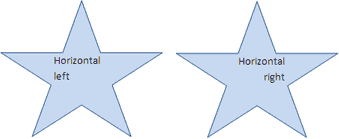Position text in a shape or text box in Outlook 2007
Text boxes and most shapes (except for lines, connectors, and freeform shapes) can include text that attaches to the shape or text box and can be positioned horizontally or vertically or wrapped. You can also change the margins of text boxes and shapes for optimal spacing or resize shapes for a better text fit.
What do you want to do?
Position text horizontally or vertically in a shape or text box
You can specify the horizontal or vertical alignment of text in a shape or a text box.
Horizontal alignment

-
Select the text that you want to position horizontally.
-
On the Message tab, in the Paragraph group, click the alignment option that you want.

Vertical alignment

-
Right-click the border of the shape or text box.
-
On the shortcut menu, do one of the following:
-
For a shape, click Format AutoShape, and then click the Text Box tab.
Note: The Text Box tab is unavailable in a shape unless the shape contains text.
-
For a text box, click Format Text Box, and then click the Text Box tab.
-
-
Under Vertical alignment, click the option that you want.
Wrap text in a shape or text box
When you wrap text, the text appears on multiple lines inside a shape or text box.
-
Right-click the border of the shape or text box that contains the text that you want to wrap.
-
On the shortcut menu, do one of the following:
-
For a shape, click Format AutoShape, and then click the Text Box tab.
Note: The Text Box tab is unavailable in a shape unless the shape contains text.
-
For a text box, click Format Text Box, and then click the Text Box tab.
-
-
Under Options, select the Word wrap text in AutoShape check box.
Change the margins between text and the edge of a shape or text box
The internal margin is the changeable distance between text and the outer border of a shape or text box.
-
Right-click the border of the shape or text box that contains the margin that you want to adjust.
-
On the shortcut menu, do one of the following:
-
For a shape, click Format AutoShape, and then click the Text Box tab.
Note: The Text Box tab is unavailable in a shape unless the shape contains text.
-
For a text box, click Format Text Box, and then click the Text Box tab.
-
-
Under Internal margin, do one or more of the following:
-
To specify the distance between the left border of a shape and the text, enter the new margin number in the Left box.
-
To specify the distance between the right border of a shape and the text, enter the new margin number in the Right box.
-
To specify the distance between the top border of a shape and the text, enter the new margin number in the Top box.
-
To specify the distance between the bottom border of a shape and the text, enter the new margin number in the Bottom box.
-
Resize a shape or text box to fit text
You can automatically increase the size of a shape or text box vertically so that text fits inside it.
-
Right-click the border of the shape or text box that you want to resize.
-
On the shortcut menu, do one of the following:
-
For a shape, click Format AutoShape, and then click the Text Box tab.
Note: The Text Box tab is unavailable in a shape unless the shape contains text.
-
For a text box, click Format Text Box, and then click the Text Box tab.
-
-
Under Options, select the Resize AutoShape to fit text check box.
No comments:
Post a Comment